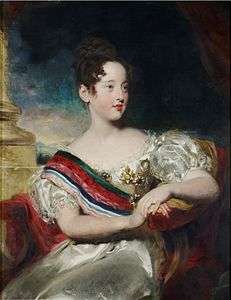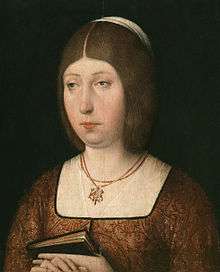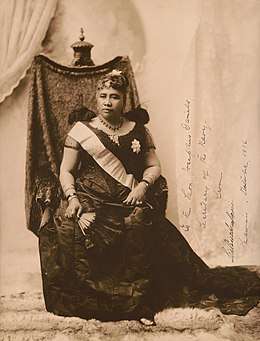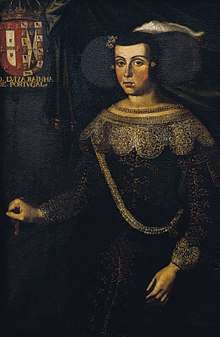List of queens regnant
This is a list of Queens who have ruled as Queen in many countries (Separate queens for separate countries). Included also are Pharaohs and Empresses, as well as other titles in case of smaller states (Grand Duchess, Archduchess, Duchess, Princess, etc.) If the Queen ruled as a regent this is indicated by "(regent)" following the name. Where a queen had no powers but only the title "(titular)" is added.
Queens consort (who are styled Queen by virtue of marrying a monarch) are not included.
The following is an incomplete list of queens who are well known from popular writings, although many ancient and poorly documented ruling queens (such as those from Africa and Oceania) are omitted. Section 1 lists Queens regnant: Queens who ruled in their own right. Section 2 lists Queens regent: Queens who have ruled on behalf of a monarch who was a minor, absent or incapacitated. Section 3 includes Legendary Queens. Section 4 lists Titular Queens: Queens who ruled in their own right, but had no constitutional standing or regal powers while in power. Section 5 lists various female leaders who were referred to as "Chieftainess."
Queens regnant
Africa
Egypt
- Sobekneferu of the Twelfth Dynasty - Sobekneferu was the first confirmed female ruler of Egypt, although Nitocris may have ruled in the Sixth Dynasty, and there are five other women who are believed to have ruled as early as the First Dynasty
- Hatshepsut of the Eighteenth Dynasty
- Neferneferuaten of the Eighteenth Dynasty (possibly Nefertiti or Meritaten or Neferneferuaten Tasherit)
- Twosret of the Nineteenth Dynasty
- Merneith of the First Dynasty - Merneith may have ruled Egypt as Pharaoh, although her reign as sole ruler is unconfirmed. If she did rule, she would have been the first female Pharaoh in Egyptian history.
- Nitocris of the Sixth Dynasty - Nitocris is mentioned within Herodotus' book Histories as being the last Pharaoh of the Sixth Dynasty of Egypt; some contest her historicity.
- Khentkawes I of the Fourth Dynasty - Khentkawes' rule as Pharaoh is highly contested by modern historians, who debate on the exact meaning behind her given title.
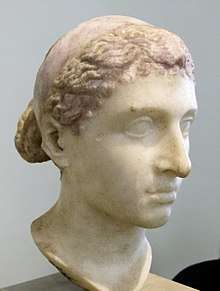
Ptolemaic dynasties
Ptolemy II instituted a new practice of brother-sister marriage when he married his full sister, Arsinoe II. They became, in effect, co-rulers, and both took the epithet Philadelphus ("Brother-Loving" and "Sister-Loving"). Because of this custom many of the kings ruled jointly with their spouses, who were also of the royal house. The only Ptolemaic Queens to officially rule on their own were Berenice III and Berenice IV. Cleopatra VI did co-rule, but it was with another female, Berenice IV. Cleopatra VII officially co-ruled with Ptolemy XIII Theos Philopator, Ptolemy XIV, and Ptolemy XV, but effectively, she ruled Egypt alone
- Arsinoe II
- Arsinoe III
- Cleopatra I
- Cleopatra II
- Cleopatra III
- Cleopatra IV
- Berenice III
- Cleopatra V
- Cleopatra VI
- Berenice IV
- Cleopatra VII
- Arsinoe IV
- Shajar al-Durr (ruled 1250)
Libya
- Cleopatra Selene II (ruled 34–30 BC) - also known as Cleopatra VIII. In 75 BC, Cyrene became part of a Roman province, but it was restored to the Ptolemies by Mark Antony in 37 BC. In 34 BC Cleopatra VII and Antony's daughter, Cleopatra Selene II, was made Queen of Cyrene, but the city returned to Rome following Augustus' conquest of Egypt in 30 BC
Sudan
Kandake was a title for queens, queen mothers, and queens consort in Nubia, but ruling Kandakes may have included:
- Alakhebasken (ruled c. 295 BCE)
- Shanakdakhete (ruled 177–155 BCE)
- Amanirenas (ruled 40–10 BCE)
- Amanishakheto (ruled c. 10 BCE–1 CE)
- Nawidemak
- Amanitore (ruled 1–20 CE)
- Amantitere (ruled 22–41 CE)
- Amanikhatashan (ruled 62–85)
- Maleqorobar (ruled 266–283)
- Lakhideamani (ruled 306–314)
Gambia
- Elizabeth II (ruled 1965-1970)
Ghana
- Elizabeth II (ruled 1957-1960)
- Amoako Atta Yiadom (ruled 1770–1793), Denkyirahene
- Ama Serwah (ruled 1838–1846), Dwabenhene
- Unknown Dwabenhene (ruled 1846-18??)
- Nana Juaben Serwah II (ruled 1959–19??), Dwabenhene
Côte d'Ivoire
Nigeria
- Elizabeth II (1960-1963)
- Emose
- Orrorro
- Pupupu, founder and ruler of the Ondo Kingdom c. 1510.
- Amina - There is controversy among scholars as to the date of her reign, one school placing her in the mid-15th century, and a second placing her reign in the mid to late 16th century
Senegal
- Lingeer Fatim Beye (ruled c. 1335)
Waalo
- Lingeer Ndoye Demba (ruled c. 1367) - she was the founder of the Serer Joos Maternal Dynasty
Angola
Jaga

- Mwongo Matamba (ruled ?–1631)
- Ana I de Sousa Nzinga Mbande (ruled 1631–1663)
- Barbara (ruled 1663–1666)
- Verónica I Guterres Kandala Kingwanga (ruled 1681–1721)
- Ana II (ruled 1741–1756)
- Verónica II (ruled 1756–1758)
- Ana III (ruled 1758–?)
- Vamwene Naama
- Vamwene Yamvu
- Vamwene Mbaao ya Chinguli (ruled 1500s-early 1600s)
- Vamwene Kaamba ka Mbaao
- Vamwene Mukenge wa Lweembe, Livindamo
- Ana de Sousa Nzinga Mbande (ruled 1624–1626 and 1657–1663)
- Mukambu Mbandi (ruled 1663–1671)
Comoros
- Alimah III (ruled 1676–1711) - first known ruler and female ruler of Anjouan; at least two more women had ruled Anjouan before her: Alimah I and Alimah II
- Alimah IV (ruled 1788–1792) - she was the de facto ruler of Anjouan with sultan Abdallah I during his reigns in 1782-1788 and 1792-1796
Bamboa
- Nyau wa Faume
- Fey Beja waWabeja, Mfalme
- Ja Mhaba, Mfalme
- Hadija bint Ahmed, Mfalme
- Raketaka Jombe Sudy (ruled 1842–1865 and 1874–1878) - she ruled as regent twice, 1865-1868 and 1871-1874. After 1851 she took the name of Jumbe Fatima bint Abderremane
- Salima Machamba bint Saidi Hamadi Makadara (ruled 1888–1909)
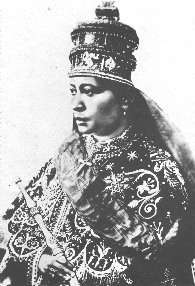
Madagascar
- Rangita (ruled 1520–1530)
- Rafohy (ruled 1530–1540)
- Ranavalona I (ruled 1828–1861)
- Rasoherina (ruled 1863–1868)
- Ranavalona II (ruled 1868–1883)
- Ranavalona III (ruled 1883–1897)
- Andrianaginarivo (ruled 1777-1778)
- Tombola (ruled 1778)
- Ravahiny (ruled 1778-1808)
- Oantitsy (ruled 1832-1836)
- Tsiomeko (ruled 1836-1840)
Mauritius
- Elizabeth II (1968-1992)
Tanzania
- Elizabeth II (1961-1962)
Malawi
- Elizabeth II (1964-1966)
South Africa
- Elizabeth II (1952-1961)
Balobedu The Modjadji or Rain Queen is the hereditary queen of Balobedu, the people of the Limpopo Province of South Africa. The succession to the position of Rain Queen is matrilineal, meaning that the Queen's eldest daughter is the heir, and that males are not entitled to inherit the throne at all. The Rain Queen is believed to have special powers, including the ability to control the clouds and rainfall.
Lovedu
- Majaji (ruled c. 350 AD)
- Maselekwane Modjadji (1800–1854)
- Masalanabo Modjadji (1854–1894)
- Khetoane Modjadji (1895–1959)
- Makoma Modjadji (1959-1980)
- Mokope Modjadji (1981-2001)
- Makobo Modjadji (2003-2005)
Batlokwa
- Mantatisi (ruled 1820s)
Makololo
- Mamochisane (c. 1851)
America
Mexico
- Tlapalizquixochtzin (ruled late 15th-early 16th century)
- Ix Yohl Ik'nal (ruled 583–604)
- Sak K'uk', also known as Muwaan Mat (ruled 612–615)
- Azcasuch (ruled late 15th-early 16th century)
- Ik' Skull, also known as Lady Eveningstar (possibly ruled 742–752)
Central America and the Caribbean
Antigua and Barbuda
- Elizabeth II (ruled 1981–)
Bahamas
- Elizabeth II (ruled 1973–)
Barbados
- Elizabeth II (ruled 1966–)
Belize
- Elizabeth II (ruled 1981–)
Grenada
- Elizabeth II (ruled 1974–)
Guatemala

- Wac Chanil Ahau, also known as Lady Six Sky (ruled 682–693)
- Unen Bahlam (ruled c. 317)
- Lady of Tikal (ruled 511–527?)
Jamaica
- Elizabeth II (ruled 1962–)
Saint Lucia
- Elizabeth II (ruled 1979–)
Saint Vincent and the Grenadines
- Elizabeth II (ruled 1979–)
Guyana
- Elizabeth II (ruled 1966-1970)
Trinidad and Tobago
- Elizabeth II (ruled 1962-1976)
Asia
East and Central Asia
China
There have been many powerful empress consorts or empress dowagers, some of whom effectively ruled. Powerful empress consorts or empress dowagers were de facto rulers, but not de jure empress regnants. A concubine who gave birth to a crown prince also could become empress consort (皇后), although her status still was a little lower than an empress dowager who had been the former empress consort which will be known as 太后.
- Wu Zetian (Chinese: 武則天; ruled 684–705, reigned 690–705) - the sole official Chinese Empress Regnant, the empress consort of Tang Gaozong, the mother of Tang Zhongzong and Tang Ruizong, she established the Zhou Dynasty (also known as Wu Zhou 武周) after dismissing her sons and becoming the Empress Regnant
Although Wu Zetian is the only undisputed empress regnant in Chinese history, there is one documented case of a woman holding the title of "Emperor":
- Daughter of Emperor Xiaoming of Northern Wei (Chinese: 元氏 (北魏孝明帝女); ruled 1–2 April 528) - during Northern Wei Dynasty, Empress Dowager Hu, after her son Emperor Xiaoming of Northern Wei's death, falsely declared Emperor Xiaoming's daughter to be a son and declared the daughter to be the new emperor, but almost immediately revealed that the child was in fact female, and thereafter declared Yuan Zhao, the young son of Emperor Xiaoming's cousin Yuan Baohui (元寶暉) emperor. Emperor Xiaoming's daughter is also therefore not usually considered a true emperor.
Japan
- Queen Himiko, of Yamatai (ruled 189–248)
- Empress Suiko (554–628), (ruled 593–628) — first ruling empress
- Empress Kōgyoku (594–661), (ruled 642–645) — formerly Princess Takara (Empress Consort of Jomei)
- Empress Saimei (594–661), (ruled 655–661) — same person as Empress Kōgyoku, second reign under a second name
- Empress Jitō (645–702), (ruled 690–697)
- Empress Genmei (661–721), (ruled 707–715)
- Empress Genshō (680–748), (ruled 715–724) — formerly Princess Hidaka
- Empress Kōken (718–770), (ruled 749–758)
- Empress Shōtoku (718–770), (ruled 764–770) — same person as Empress Kōken, second reign under a second name
- Empress Meishō (1624–1696), (ruled 1629–1643)
- Empress Go-Sakuramachi (1740–1813), (ruled 1762–1771) — last ruling empress
India
- Razia Sultana (ruled 10 October 1236 − 14 October 1240) 5th Sultana of the Delhi Sultanate
- Ballamahadevi (ruled 1275–1285 with Nagadevarasa)
Arakkal dynasty
- Ali Raja Bibi Harrabichi Kadavube (ruled 1728–1732)
- Ali Raja Bibi Junumabe I (ruled 1732–1745)
- Ali Raja Bibi Junumabe II (ruled 1777–1819)
- Victoria (ruled 1876–1901) - Empress of India
- Ahilyabai Holkar (ruled 1767–1795), also known as the Philosopher Queen
- Lakshmi Bai (ruled 1857–1858)
- Rani Rudrama Devi (ruled 1261/62–1295/96)
- Sugandha (ruled in the 10th century)
- Didda (ruled 980–1003), she ruled first as a Regent for her son Abhimanyu and thereafter as sole ruler in her own right
- Kota Rani (ruled 1338–1339)
Keladi Nayaka dynasty
- Keladi Chennamma (ruled 1672–1697)
- Virammaji (ruled 1757–1763)
- Kittur Chennamma (ruled ?-1829)
Mamluk dynasty
- Raziyyat-ud-din Sultana of Slave Dynasty (ruled 1236–1240)
Princely States
- Gowri Lakshmi Bayi of Travancore (ruled 1811–1814)
- Qudsia Begum (ruled 1819–1837) - in 1819, 18-year-old Qudsia Begum (also known as Gohar Begum) took over the reins after the assassination of her husband, Nawab Muiz Muhammad Khan Bahadur. She was the first female ruler of Bhopal. She declared that her 2-year-old daughter Sikander would follow her as the ruler; none of the male family members dared to challenge her decision. She ruled till 1837, when she died having adequately prepared her daughter for ruling the state.
- Begum Sultan Shah Jehan (ruled 1844–1860 and 1868–1901) - Shahjahan was the only surviving child of Sikandar Begum, sometime Nawab of Bhopal by correct title, and her husband Jahangir Mohammed Khan. She was recognised as ruler of Bhopal in 1844 at the age of six; her mother wielded power as regent during her minority. However, in 1860, her mother Sikandar Begum was recognised by the British as ruler of Bhopal in her own right, and Shahjahan was set aside.
- Begum Nawab Sikandar (ruled 1860–1868)
- Begum Kaikhusrau Jahan (ruled 1901–1926)
- Abbakka Chowta (ruled 1525–1570s)
Maldives
- Damahaar (ruled before 990) - Damahaar, a Ranin (Queen) of the Aadeetta (Sun) Dynasty, is mentioned by al-Idrisi as having reigned over the Maldives at some time before the semi-legendary King Koimala; there are several other mentions by foreign travelers, mainly Arabs, of queens ruling over the Maldives at various times; these are not always named and their reigns cannot be precisely dated
- Khadijah (ruled 1347–1363, 1364–1374 and 1376–1380) - She is one of the earliest female rulers in a Muslim nation.
- Raadhafathi (ruled 1380)
- Dhaain (ruled 1385–1388)
- Kuda Kala Kamanafa’anu (ruled 1607–1609)
- Amina (ruled 1757 – 1759)
Sri Lanka
- Kuweni of Thambapanni (ruled before 543BC)
- Anula of Anuradhapura (ruled 47–42 BC)
- Sivali of Anuradhapura (ruled 35)
- Chattagahaka Jantu of Anuradhapura (ruled 434–435)
- Lilavati of Polonnaruwa (ruled 1197–1200, 1209–1210 and 1211–1212)
- Kalyanavati of Polonnaruwa (ruled 1202–1208)
- Elizabeth II of Ceylon (ruled 1952-1972)
Cambodia
- Jayavedi (ruled 681–713) - during her rule, She was faulted in leadership which led The Chenla kingdom to break into two individual states, but then it record the period to be female-dominated dynasty with the wide range of female successors, totally driving the entire kingdom
- Ang Mey (1835–1841 and 1844–1845) - also known as Ngọc Vân Quận chúa (Lady Ngọc Vân - Vietnamese) or Ksat Trey, she was proclaimed on the death of her father by the Vietnamese faction at court with the title of Mỹ Lâm Quận chúa (Lady Mỹ Lâm - Vietnamese) in January 1835. She was famous as a Vietnamese puppet queen
Indonesia
- Seri Ratu Ta'jul Alam Shah (ruled 1641–1675) - the Sultana of Atjeh (Aceh) Darussalam, formerly known as Puteri Seri Alam the Daughter of The Great Sultan Iskandar Muda, and wife of Sultan Iskandar Thani
- Seri Ratu Naqiatuddin Nurul Alam (ruled 1675-1678)
- Seri Ratu Inayat Shah (ruled 1678–1688)
- Seri Ratu Kamalat Syah (ruled 1688–1699) - she was deposed and replaced by her husband under pressure from the Mufti of Mecca
- Śri Wijaya Mahadewi (ruled c. 983)
- Mahendradatta (ruled before 989–1007)
- Śri Ajñadewi (ruled c. 1016)
- Śri Sakalendukirana Laksmidhara Wijayottunggadewi (ruled c. 1088–1101)
- Arjayadengjayaketana (ruled c. 1200)
- Unnamed Queen (ruled ?–1284)
- Dewa Agung Istri Kanya (ruled 1814–1850)
- Siti Aisyah We Tenriolle (ruled 1855-1910)
- Maharani Shima (ruled 674–695)
- Tribhuwana Wijayatunggadewi (ruled 1328–1350)
- Suhita (ruled 1429–1447)
- Pramodhawardhani (ruled 833–856 with her husband Rakai Pikatan)
- Śri Isyana Tunggawijaya (ruled 947–985)
Mengwi
- Gusti Ayu Istri Biang Agung (ruled 1836–1857)
- Bi Sonbai (ruled 1672–1717), in western Timor
Laos
- Nang Keo Phimpha (ruled 1438) - after her nephew Lan Kham Deng died, she seized control of Lan Xang and the next four kings were under her control. She only reigned for a few months in 1438 at age of 95; she was deposed and killed
Thailand
- Jamadevi, first ruler of the Mon kingdom of Hariphunchai
- Ratu Hijau, 'the Green Queen' (ruled 1584–1616)
- Ratu Biru, 'the Blue Queen' (ruled 1616–1624)
- Ratu Ungu, 'the Purple Queen' (ruled 1624–1635)
- Ratu Kuning, 'the Yellow Queen' (ruled 1635–1649/88), controversy surrounds the exact date of the end of her reign
- Ratu Emas Kelantan (ruled 1670–1698 or 1690–1704) - thought by A. Teeuw & Wyatt to be a king, but claimed by al-Fatani to be a queen, the widow of Raja Bakal and mother of the succeeding queen
- Ratu Emas Chayam (ruled 1698–1702 or 1704–1707 and 1716–1718)
- Chiraprapha (ruled 1545–1546)
- Wisutthi Thewi (ruled 1564-1578)
Vietnam
- Queen Trưng Trắc (ruled 40–43) - the Trưng sisters (Vietnamese: Hai Bà Trưng; literally: two ladies Trưng) were leaders who rebelled against Chinese rule for three years, and are regarded as national heroines of Vietnam. Her name is Trưng Trắc.
- Empress Lý Chiêu Hoàng (ruled 1224–1225)
- Isanavarman (ruled 653)
West Asia
Iran
- Musa of Parthia (Parthian queen regnant of Iran, ruled 2 BC–4 AD)
- Pourandukht (In Persian: Pourandokht, Sassanid queen regnant and Daughter of Khosrow Parviz, ruled 629-630 and 631-632)
- Azarmidokht (Sassanid queen regnant, sister of Pourandukht and daughter of Khosrow Parviz, ruled 630–631)
- Anzaze (ruled about 82/81 to 75 BC, following dates on the coins), she appears on coins together with king Kamnaskires III; they perhaps ruled together as on the coins she is called βασιλίσσης (the Genitive case of queen, βασίλισσα - basílissa)
Il Khanate
- Sati Beg (ruled 1338–1339)
- Abish Khatun b. Sa'd II (ruled 1263)
- Abish Khatun w (ruled 1264–1282)
Israel
- Athaliah (ruled 843–835 BC)
- Salome Alexandra (ruled 76–67 BC)
- Salome I (ruled 6 BC-10 AD) - she ruled as Toparch of Jabneh, Ashdod and Phasaelis
- Livia (ruled 10-29) - she ruled as Toparch of Jabneh
- Melisende (ruled 1131–1153) - she ruled with her husband Fulk of Anjou and her son Baldwin III as co-rulers
- Sibylla (ruled 1186–1190) - she ruled with her husband Guy de Lusignan as co-ruler
- Isabella I (ruled 1190/92–1205) - she ruled with her husbands Conrad of Montferrat, Henry of Champagne and Aimery of Cyprus as co-rulers
- Maria (ruled 1205–1212) - she ruled with her husband John of Brienne as co-ruler from 1210
- Isabella II (ruled 1212–1228), also known as Yolande of Jerusalem - she ruled with her husband Frederick II of Hohenstaufen as co-ruler from 1225
Jordan
Nabatea
- Chuldu (ruled 9 BC–40 AD), she ruled jointly with her husband Aretas IV Philopatris
- Shaqilath (ruled 40–70/71), she ruled jointly with her husband-brother Malichus II; after his death she was regent for her son Rabbel II Soter
- Gamilath (ruled 70/71–106), she ruled jointly with her brother Rabbel II Soter
Saudi Arabia
- Zabibe (ruled c. 750–735 BC)
- Samsi (ruled c. 735–710 BC)
- Yatie (ruled c. 710–695 BC)
- Te'elkhunu (ruled c. 695–690 BC)
- Tabua (ruled c. 678–675 BC)
Syria
- Mavia (ruled 375–425) - "The Queen of the Arabs"
- Cleopatra Thea (ruled 126–121 BCE) - she ruled in association with her son Antiochus VIII Grypus
Turkey
- Artemisia I (ruled c. 480 BC)
- Artemisia II (ruled 353–351 BC)
- Ada (ruled 344–340 and 334–326 BC)
Dardania
- Amastris (ruled c. 300-284 BC)
- Pythodorida (ruled 8 BC–38 AD)
- Orodaltis (ruled c. after 30 BC)
Saltukid dynasty
- Melike Mama Hatun (ruled 1191–1200)
- Theodora Megale Komnene (ruled 1284–1285)
- Eirene Palaiologina (ruled 1340–1341)
- Anna Megale Komnene (ruled 1341–1342)
Yemen
- Asma bint Shihab (ruled 1047-1087) - she was the co-ruler of Yemen in co-regency with her cousin and spouse, Ali al-Sulayhi, and later her son, Ahmad al-Mukkaram, and daughter-in-law, Arwa al-Sulayhi. Though there were many female monarch in the Muslim world, Asma bint Shihab and Arwa al-Sulayhi were the only female monarchs in the Arab world to have had the khutba proclaimed in their name in the mosques as sovereigns
- Arwa al-Sulayhi (ruled 1067–1138) - she ruled Yemen firstly with her first two husbands and her mother-in-law and then as sole ruler. She was the greatest of the rulers of the Sulayhid Dynasty and was also the first woman to be accorded the prestigious title of hujja in Isma'ili branch of Shi'a Islam, signifying her as the closest living image of God's will in her lifetime
Andorra
- Isabella (ruled 1398–1413)
- Catherine (ruled 1483–1512, 1513–1517)
- Jeanne d'Albret (ruled 1555–1572)
Armenia
- Erato (ruled 10–2 BC and 6–12 AD)
- Zarmandukht (ruled 378–384)
Austria
- Maria Theresa (Archduchess) (ruled 1740-1780) - she was the only female ruler of the Habsburg dominions and the last of the House of Habsburg. She was the sovereign of Austria, Hungary, Croatia, Bohemia, Mantua, Milan, Lodomeria and Galicia, the Austrian Netherlands and Parma. In some of the Habsburg dominions (such as Hungary, Croatia, Bohemia and Lodomeria and Galicia), she held the title of queen. By marriage, she was also Duchess of Lorraine, Grand Duchess of Tuscany and Holy Roman Empress (all as consort).
Marcomanni
- Fritigil (ruled mid 4th century)
Odrysian kingdom
- Antonia Tryphaena (ruled 18–38), co-ruling with Rhoemetalces II, son of Raskouporis II
- Pythodoris II (ruled 38–46), co-ruling with Rhoemetalces III, son of Cotys
Bosnia
- Jelena Gruba (ruled 1395–1398)
Croatia
- Mary (ruled 1382–1385 and 1386–1395)
- Maria Theresa (Queen) (ruled 1740–1780)
Cyprus
- Charlotte (ruled 1458–1464)
- Catherine Cornaro (ruled 1474–1489)
- Elizabeth II (ruled 1952–1960)
Denmark
- Margaret I (ruled 1387–1412) - she was founder of the Kalmar Union, which united the Scandinavian countries for over a century. Margaret is known in Denmark as "Margrethe I" to distinguish her from the current queen. Denmark did not have a tradition of allowing women to rule, so when her son died, she was titled "All-powerful Lady and Mistress (Regent) of the Kingdom of Denmark". She only styled herself Queen of Denmark in 1375, usually referring to herself as "Margaret, by the grace of God, daughter of Valdemar King of Denmark" and "Denmark's rightful heir" when referring to her position in Denmark. Others simply referred to her as the "Lady Queen", without specifying what she was queen of, but not so Pope Boniface IX, who in his letters styled her "our beloved daughter in Christ, Margaret, most excellent queen of Denmark, Sweden and Norway"
- Margaret II (rule 1972–present)
Estonia
- Margaret Sambiria (ruled 1266-1282)
- Christina (ruled 6 November 1632 – 6 June 1654)
- Ulrica Eleanor (ruled 5 December 1718 – 29 February 1720)
- Catherine I (ruled 8 February 1725 – 17 May 1727)
- Anna (ruled 13 February 1730 – 28 October 1740)
- Elizabeth (ruled 6 December 1741 – 5 January 1762)
- Catherine II (ruled 9 July 1762 – 6 November 1796)
Finland
- Margaret I of Denmark (ruled 1389–1412)
- Christina of Sweden (ruled 1632–1654)
- Ulrika Eleonora of Sweden (ruled 1719–1720)
Antiquity
Aeacid dynasty
- Deidamia II (ruled c. 233 BCE)
Byzantine Empire and immediate successors
Isaurian dynasty
- Irene (ruled 797-802)
Macedonian Dynasty
- Zoe (ruled 1028–1041 and 1042–1050) - she ruled with her consorts Romanos III and Michael IV between 1028 and 1041; she ruled with her sister Theodora and her third husband Constantine IX from 1042 to 1050
- Theodora (ruled 1042–1056) - she ruled from 1042 jointly with her sister Zoe and Zoe's third husband Constantine IX; she ruled from 1055 until her own death as sole monarch.
Epirus
- Maria Angelina Doukaina Palaiologina (ruled 1384–1385)
Hungary
- Mary (ruled 1382–1385 and 1386-1395) - she was crowned as King of Hungary to emphasize that she was a monarch in her own right; she co-ruled with her husband Sigismund of Luxembourg from 1387
- Maria Theresa (Queen, "King") (ruled 1740–1780)
Iceland
- Margaret I (ruled 1388 – 28 October 1412)
Kingdom of Ireland
- Jane Grey (ruled 1553) (disputed)
- Mary I (ruled 1553–1558)
- Elizabeth I (ruled 1558–1603)
- Mary II (ruled 1689-1694) - she co-ruled with her husband William of Orange
- Anne (ruled 1702–1714)
Naples
- Joan I (ruled 1343–1382)
- Joan II (ruled 1414–1435)
- Joan III the Mad (ruled 1516–1555)
Parma
- Maria Theresa (Duchess) (ruled 1740–1748)
- Marie Louise (Duchess) (ruled 1814-1847)
Sardinia
- Elena of Gallura (ruled 1202 or 1203–1218)
- Benedetta of Cagliari (ruled 1214–1232 or 1233)
- Adelasia of Torres (ruled 1236–1259)
- Joanna of Gallura (ruled 1298–1308)
- Eleanor of Arborea (ruled 1383–1404)
Sicily
- Constance I (ruled 1194–1198) - she co-ruled with her husband Henry of Hohenstaufen until 1197
- Constance II (ruled 1282–1285) - she co-ruled with her husband Peter III of Aragon
- Maria (ruled 1377–1401) - she co-ruled with her husband Martin I the Younger from 1392
- Joan the Mad (ruled 1516–1555)
Luxembourg
- Marie-Adélaïde (Grand Duchess) (ruled 1912-1919)
- Charlotte (Grand Duchess) (ruled 1919-1964)
Monaco
- Claudine (Lady) (ruled 1457-1458)
- Louise Hippolyte (Princess) (ruled 1731)
Netherlands
- Wilhelmina (ruled 23 November 1890 – 4 September 1948)
- Juliana (ruled 4 September 1948 – 30 April 1980)
- Beatrix (ruled 30 April 1980 – 30 April 2013)
Poland
- Hedwig (ruled 1384–1399) - she was crowned as King of Poland to emphasize that she was a monarch in her own right; she co-ruled with her husband Władysław II Jagiełło from 1386
- Anna (ruled 1575–1586) - she was crowned as King of Poland and Grand Duke of Lithuania to emphasize that she was a monarch in her own right; she co-ruled with her husband Stephen Báthory
Princes of Transylvania
- Catherine of Brandenburg (Princess) (ruled 1629 - 1630)
Principality of Transylvania
- Maria Theresa (Grand Princess) (ruled 1740 - 1780)
Russia
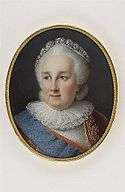
- Catherine I (ruled 1725–1727)
- Anna (ruled 1730–1740)
- Elizabeth (ruled 1741–1762)
- Catherine II ("the Great") (ruled 1762–1796)
Kingdom of the Cimmerian Bosporus
- Dynamis (ruled in 47 BC, 44-17 BC and 16-14 BC) - she co-ruled with her first husband Asander in 47 BC and from 44 BC until 17 BC; then she co-ruled with her second husband Polemon I from 16 BC until her death
- Gepaepyris (ruled 38–45) - she ruled in association with her son Mithridates III
Spain
- Urraca of León and Castile (ruled 1109–1126) - also styled as Empress of all the Spains (totius Hispaniae imperatrix). Her use of the imperial styling was limited, much more so than that of her predecessor and successor (it is possible that the imperial style had connotations too strongly masculine). Urraca did employ instead the title Queen of Spain on several occasions from the very beginning of her reign until the end
- Petronila of Aragon (ruled 1137–1164)
- Berenguela of Castile the Great (ruled 1217)
- Sancha of León (ruled de jure 1230) - she ruled jointly with her sister Dulce. After the death of Sancha's brother, Alfonso IX named his second son, Ferdinand, his heir, bestowing on him the title infante. In 1217, Ferdinand's mother, Berengaria, inherited the Kingdom of Castile, but ceded it to her son. With his heir out of the kingdom and ruling in another place, Alfonso attempted to make his eldest daughters his joint heirs. In the Treaty of Boronal concluded with Portugal in 1219, Alfonso expressly states that if he should die, Portugal should respect the agreement with his daughters.[2] Alfonso also attempted to secure his eldest daughter's rights by marrying Sancha to John of Brienne, the former King of Jerusalem, but his wife Berengaria blocked this action in order to advance her son.[3] After this fiasco, Alfonso declared Sancha and Dulce his heirs, but upon his death on 24 September 1230, the people of León, who had pledged for Ferdinand in 1206, refused to recognise his daughters, and they in turn ceded their rights to his kingdom to their half-brother
- Dulce of León (ruled de jure 1230) - she ruled jointly with her sister Sancha
- Isabella I of Castile the Catholic (ruled 1474–1504) - After a struggle to claim her right to the throne, she reorganised the governmental system, brought the crime rate to the lowest it had been in years, and unburdened the kingdom of the enormous debt her brother had left behind. Her marriage with Ferdinand II of Aragon brought stability to the kingdoms that became the basis for the political unification of Spain. Her reforms and those she made with her husband had an influence that extended well beyond the borders of their united kingdoms. Isabella and Ferdinand are known for completing the Reconquista, ordering conversion or exile of their Muslim and Jewish subjects in the Spanish Inquisition, and for supporting and financing Christopher Columbus's 1492 voyage that led to the opening of the New World.
- Joanna of Castile and Aragon the Mad (ruled 1504–1555) - successor of the previous. After her husband's death she was deemed mentally ill and was confined to a nunnery for the rest of her life. Her father, Ferdinand II of Aragon, was regent until his death, when she inherited his kingdom as well.
- Isabella II of Spain (ruled 1833–1868)
Navarre
- Toda Aznárez (ruled 950s-970s) - was the queen consort of Pamplona through her marriage to Sancho I, who reigned from 905 to 925, and was regent of Pamplona for her son García Sánchez I from 931 to 934. Later in life, she ruled a subkingdom created for her
- Joan I (ruled 1274–1305)
- Joan II (ruled 1328–1349)
- Blanche I (ruled 1425–1441)
- Blanche II (ruled de jure 1461–1464)
- Eleanor (ruled in 1479)
- Catherine (ruled 1483–1517)
- Joan III (ruled 1555–1572)
Sweden

Galicia and Lodomeria
- Maria Theresa (Queen) (ruled 1772–1780)
Kingdoms of the Britons
- Cartimandua (ruled c. 43–69), queen of the Brigantes, a Celtic people in what is now Northern England - she came to power around the time of the Roman conquest of Britain, and formed a large tribal agglomeration that became loyal to Rome; she is known exclusively from the work of a single Roman historian, Tacitus, though she appears to have been widely influential in early Roman Britain
- Boudica (ruled c. 60–61), queen of the Brythonic Celtic Iceni, people of Norfolk, in Eastern Britain - in 61 AD, led a major uprising of the tribes against the occupying forces of the Roman Empire
Anglo-Saxon kingdoms
- Seaxburh of Wessex (ruled c. 672–674) - she reigned jointly with her husband Cenwalh and, according to tradition, ruled Wessex as Queen for a year following Cenwalh's death in c. 672
- Æthelflæd of Mercia (ruled 911–918) - eldest daughter of king Alfred the Great of Wessex, wife of Æthelred II, ealdorman of Mercia, and after his death, sole ruler of Mercia. While her husband was alive, she signed agreements, leading some to think that she was the real leader. The Anglo-Saxon Chronicle styles her Lady of the Mercians (Myrcna hlæfdige)
- Ælfwynn of Mercia (ruled 918) - daughter of Æthelflæd and Æthelred II, styled Lady of the Mercians. Deposed by her uncle, Edward the Elder (4 December 918), who annexed Mercia to Wessex, creating the Kingdom of England
Kingdom of England
- Matilda (ruled 7 April – 1 November 1141) - she was England's first de facto female ruler, holding the title of Lady of the English (she planned to assume the title of queen upon her coronation). She was declared heir presumptive by her father, Henry I, and acknowledged as such by the barons; however, upon the death of her father in 1135, Matilda's rival and cousin Stephen of Blois usurped the throne. The Anarchy followed, with Matilda's being a de facto ruler for a few months in 1141, but she was never crowned and failed to consolidate her rule (legally and politically)
- Jane (ruled 1553, disputed) - her cousin Edward VI of England nominated Jane as successor to the Crown in his will and excluded his half sisters, Mary and Elizabeth. However, this was disputed following Edward's death, since parliament had not ratified his action and Jane was ‘queen’ for only nine days (10–19 July) before Edward's half-sister, Mary, was proclaimed Queen. Jane is nicknamed The Nine Days' Queen
- Mary I (ruled 1553–1558)
- Elizabeth I (ruled 1558–1603)
Kingdom of Scotland
- Margaret, Maid of Norway (ruled 25 November 1286 – 26 September 1290) She was daughter of Eric II of Norway and Margaret of Scotland and was named "domina and right heir" of the Kingdom of Scotland by her grandfather, Alexander III. Her death, at the age of seven, while en route to Scotland sparked off the disputed succession which led to the Wars of Scottish Independence. As Margaret was never crowned or otherwise inaugurated, and never set foot on what was then Scottish soil during her lifetime, there is some doubt about whether she should be regarded as a Queen of Scots; this could ultimately be a matter of interpretation. Most lists of the monarchs of Scotland do include her, but a few do not.
- Mary, Queen of Scots (ruled 1542–1567) - she was executed in England in 1587
Kingdoms of England and Scotland / Kingdom of Great Britain
- Mary II (ruled 1689–1694) - she ruled jointly with her cousin and husband William III of Orange
- Anne (ruled 1702–1714)
United Kingdom
- Victoria (ruled 1837–1901) - the first monarch to hold the title of Empress of India.
- Elizabeth II (ruling 1952–present) - head of state of 16 sovereign states, longest-reigning British monarch, longest-reigning queen regnant and female head of state in world history and, since October 2016, the longest currently reigning monarch and head of state.
Oceania
American Samoa
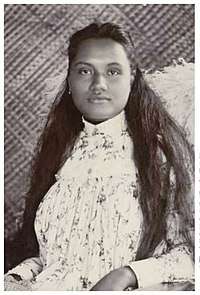
- Tuimanufili, (ruled as 20th Tui Manu'a)
- Siliave, (ruled as 23rd Tui Manu'a)
- Seuea, (ruled as 27th Tui Manu'a)
- Matelita, (ruled 1891–1895, as 39th Tui Manu'a)
Bora Bora
- Teriimaevarua II (ruled 1860–1873)
- Teriimaevarua III (ruled 1873–1888)
Huahine
- Teha'apapa I (ruled 1760–1790)
- Teri'itaria II (ruled 1815–1852)
- Teha'apapa II (ruled 1868–1893)
- Teuhe (ruled 1888–1890) - she reigned under a rebellion government against her mother Queen Tehaapapa II
- Teha'apapa III (ruled 1893–1895)
Raiatea
- Tehauroarii (ruled 1881–1884)
- Tuarii (ruled till 1897) – she reigned under a rebellion government against the French with the support of Teraupo'o after Tamatoa VI abdicated.
Rapa Iti
- Daughter of Parima (ruled 1886–1887).
Rimatara
- Tamaeva IV (ruled 1876–1892)
- Tamaeva V (ruled 1892–1901)
Fiji
- Elizabeth II (ruled 1970–1987)
Hawaii
- Ancient
- Kalanikauleleiaiwi, co-ruler of Hawaiʻi Island along with her brother Keaweʻīkekahialiʻiokamoku (ruled 1695–1725)
- Ululani, 7th Chiefess of Hilo
- Kapauanuakea, 3rd Chiefess of Molokai
- Kamauliwahine, 4th Chiefess of Molokai
- Hualani, 5th Chiefess of Molokai
- Kanealai, Chiefess of Molokai
- Kūkaniloko, 11th Moʻi of Oʻahu (ruled sixteenth century)
- Kalaimanuia, 12th Moʻi of Oʻahu (ruled 1600–1665)
- Kaikilani, 17th Moʻi of Hawaiʻi Island (ruled 1575–1605)
- Keakamahana, 19th Moʻi of Hawaiʻi Island (ruled 1635–1665)
- Keakealaniwahine, 20th Moʻi of Hawaiʻi Island (ruled 1665–1695)
- Kamakahelei, 22nd Moʻi of Kauaʻi (ruled 1770–1794)
- Kingdom
- Liliʻuokalani (ruled 1891–1893 and claimed status as queen until her death in 1917) - was one of many queens of Hawaii; however, she was the only queen regnant of the modern Kingdom of Hawaii established by Kamehameha I in the late eighteenth century
New Zealand
- Elizabeth II (ruling 1952–present)
Rarotonga
- Makea Takau Ariki, Queen/Supreme High Chiefess of the Cook Islands (ruled 1871–1911) - was the last monarch and only queen regnant of the Kingdom of Rarotonga established in 1858, she ceased to be sovereign after 1888
Papua New Guinea
- Elizabeth II (ruling 1975–present)
Solomon Islands
- Elizabeth II (ruling 1978–present)
Tonga
- Tupoumahe'ofo (ruled 1777–1781, as Tu'i Kanokupolu)
- Salote Tupou III (ruled 1918–1965)
Tuvalu
- Elizabeth II (ruling 1978–present)
Uvea (Wallis)
- Toifale (ruled 1825)
- Falakika Seilala (ruled 1858–1869)
- Amelia Tokagahahau Aliki (ruled 1869–1895)
- Aloisia Brial (ruled 1953–1958)
Female regents
Africa
Fatimids
- Sitt al-Mulk (regent) 1021–1023
Kongo Kingdom
- Isabel Maria da Gama (regent) 1962-1975
Ashanti Empire
- Yaa Asantewaa (regent), queen mother of Ejisu in the Ashanti Empire
Egypt
- Merneith of the First Dynasty - was a consort and a regent of Ancient Egypt during the First Dynasty. She may have been a ruler of Egypt in her own right (hence being included in the list of queens regnant as well). The possibility is based on several official records. Her rule occurred the 30th century B.C., for an undetermined period
- Khentkawes I of the Fourth Dynasty - Khentkawes may have served as a regent for Thampthis (considered by some historians her son), or she may have ruled Egypt as Pharaoh.
- Ahhotep I of the Seventeenth Dynasty
- Ankhesenpepi II of the Sixth Dynasty
- Ahmose-Nefertari of the Eighteenth Dynasty
- Khentkaus II of the Fifth Dynasty - While it is not confirmed that Khentkaus ruled as regent, several aspects of her tomb indicate she may have done so.
- Tetisheri of the Seventeenth Dynasty
Asia
Mongolia
- Töregene Khatun (regent) 1243–1246
- Oghul Qaimish (regent) 1248–1251
- Mandukhai Khatun (regent) 15th century
Chagatai Khanate
- Orqina Khatun (regent) 1252-1260
Golden Horde
- Tulun Beg Khanum (regent) 1370-1373
Kara-Khitan Khanate
- Tabuyan (regent) 1144-1150
- Yelü Pusuwan (regent) 1164–1178
Gond
- Rani Durgavati (regent) ?–1564
Maratha Empire
- Tarabai (regent) 1700–1708
Neo-Assyrian Empire
- Shammuramat (regent) 810-806 BC
Palmyrene Empire
- Zenobia (regent) 267–271
Vietnam
- Queen Cù thị (regent) 113–112 BC
- Empress Dương Vân Nga (regent) 979–981
- Empress Thượng Dương (regent) 1072–1073
- Lady Ỷ Lan (first regent 1069–1070) (second regent 1072–1085(6,?))
- Empress Linh Chiếu (regent) 1138–1158
Europe
England
- Ælfthryth (regent) 978-984
- Matilda of Flanders - ruled as regent during the absences of her husband, William the Conqueror.
- Eleanor of Aquitaine (regent) 1190-1191
- Eleanor of Provence (regent) 1253
- Isabella of France (regent) 1326-1330
- Philippa of Hainault (regent) 1346
- Joan of Navarre (regent) 1399-1403 and 1415
- Catherine of Aragon (regent) six months in 1513
- Catherine Parr (regent) July-September 1544
France
- Anne of Kiev (regent) 1060-1066
- Adela of Champagne (regent) 1190
- Blanche of Castile (regent) 1226-1235 and 1248-1252
- Isabella of Bavaria (regent) 1417-1420
- Joan the Lame - ruled as regent while her husband, Philip VI of France, fought in the Hundred Years' War.
- Catherine de' Medici (regent) in 1552, 1560-1563 and in 1574
- Marie de' Medici (regent) 1610-1614
- Anne of Austria (regent) 1643-1651
- Marie Louise (regent) 1812 and 1814
- Eugénie de Montijo (regent) 1859, 1865 and 1870
Franks
- Richilde of Provence (regent) 877
- Fredegund (regent) 584-597
- Ermentrude of Orleans 823-869
Kievan Rus'
- Olga (regent) 945-962
Lombards
- Theodelinda (regent) 590-591
Ostrogoths
- Amalasuntha (regent) 526-534
Portugal
- Leonor Teles (regent) 1383-1384
- Eleanor of Aragon (regent) 1438-1439
- Eleanor of Viseu (regent) 1497-1499
- Catherine of Austria (regent) 1557-1562
- Luisa de Guzmán (regent) 1656-1662
- Catherine of Braganza (regent) 1701; 1704-1705
- Maria Anna of Austria (regent) 1742-1750
- Mariana Victoria of Spain (regent) 1776-1777
Russia
- Olga (regent) 945-962 (during historical period of Kievan Rus')
- Sophia of Lithuania (regent) 1425-1432
- Elena Glinskaya (regent) 1533-1538
- Natalya Naryshkina (regent) 1682
- Sophia Alekseyevna (regent) 1682–1689
- Anna Leopoldovna (regent) 1740-1741
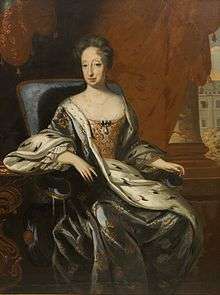
Sweden
- Ingeborg (de facto regent) 1318-1319
- Hedwig Eleanor (regent) 1660-1672 & 1697
Roman Empire and immediate successors
- Ulpia Severina (regent) 275 - there is considerable numismatic evidence for Ulpia Severina ruling in her own right between the death of Aurelian and the election of Marcus Claudius Tacitus.[4] Sources mention an interregnum between Aurelian and Tacitus, and some of Ulpia's coins appear to have been minted after Aurelian's death.[5] As such she may have been the only woman to rule over the whole Roman Empire in her own power.
Byzantine Empire
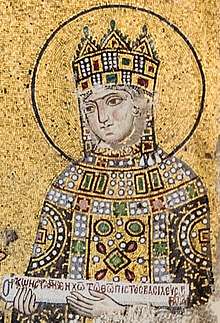
- Pulcheria (regent) 414–453
- Irene (ruled 797–802) - she normally referred to herself as basilissa (empress), although there are three instances of the title basileus (emperor) being used by her
- Theodora the Armenian (regent) 842-855
- Martina (empress) 613-641
Latin Empire
- Yolanda of Flanders (regent) 1217-1219
Ottoman Empire
- Mahpeyker Kösem Sultan (regent) 1623-1632 and 1648-1651
- Turhan Hatice Sultan (regent) 1651-1656
Legendary Queens
Amazons
- Otrera, the daughter of Eurus (the east wind)
- Hippolyta, the Amazonian queen who possessed a magical girdle
- Penthesilea, the daughter of Ares and Otrera and the sister of Hippolyta, Antiope and Melanippe
- Antianara, the daughter of Ares and Otrera and the sister of Hippolyta, Antiope and Melanippe
- Eurypyle
- Lampedo
- Marpesia
Bornu Empire
- Aissa Kili N'guirmamaramama (ruled 1573-1580)
Champa
- Lady Po Nagar, According to Cham legend, was the founder of the Cham nation
Carthage
- Dido (ruled 814 – c. 760 BC) - also known as Alyssa. Founder of Carthage, according to tradition
Funan Kingdom
- Queen Somâ (ruled 180–90 BCE) - the earliest Queen and Leader in Cambodian history
Gideons Dynasty
- Gudit, (ruled c. 960 – c. 1000)
Britain
- Queen Gwendolen (ruled 11th century BCE)
- Queen Cordelia (ruled 8th century BCE)
- Queen Marcia (ruled 4th century BCE)
Harran
- Zugalum, (ruled 2400 BC)
Japan
- Empress Jingū (ruled 201-269)
Nubia
- Kadimalo (depicted in Semna)
- Pelekh Candace of Meroë (c. 345–332 BCE)
Rapa Nui
- Vakai
Puntland
- Ati, a queen of the fabled Land of Punt in Africa
Sheba
- Bilkis in Yemen, Makeda in Ethiopia and Sudan, claimed to be Queen of Sheba
Titular Queens
Balete
- Mosadi Seboko (ruled 2002-), the kgosikgolo[a] of the Balete people in Botswana
Māori
- Te Atairangikaahu (ruled 1966-2006)
Mapuche
- Laura Teresa I (ruled 1903–1916)
Naso
- Rufina Santana (ruled 1982-1988)
Chieftainess
Crow tribe
- Pine Leaf, (ruled 1830s)
Giluts'aaw
- Victoria Young
Hispaniola
- Anacaona, Cacica of Quisqueya
- Iguanamá, also known as Isabel de Iguanamá
Pamunkey
- Cockacoeske (ruled 1656–1686)
- Queen Betty (ruled 1686–1708)
- Queen Ann (ruled 1708–1723)
Puerto Rico
- Doña Ines, mother of Caciques Agueybaná and Agüeybaná II
- Doña María, daughter of Cacique Bagnamanay
- Yuisa, Cacica in the region near Loíza, Puerto Rico
Rarotonga
- Makea Te Vaerua Ariki, High Chiefess of Te Au O Tonga (ruled 1845–1857)
- Pa Upoko Takau Ariki, High Chiefess of Takitumu (ruled 1855–1890)
- Tinomana Mereana Ariki, High Chiefess of Puaikura (ruled 1881–1908)
Rewa, Burebasaga Confederacy
- Ro Lady Lala Tuisawau-Mara, (ruled 1957 - 2004)
- Ro Teimumu Tuisawau-Kepa, (ruled 2004 -)
Seneca tribe
- Queen Alliquippa (ruled 1754)
Xhosa
- Nosizwe Tyali, Chief of Imingcangathelo
- Nosiseko Gaika, Chief of Amambombo (Ngqika)
- Nomasilakhe Komani, Chief of Imingqalasi
Notes
- "Sigismund (Holy Roman emperor)". Encyclopædia Britannica. Britannica.com Inc. Retrieved 2012-05-29.
- Yáñez Neira, 54.
- Salvador Martínez, 32–33.
- Watson, Alaric (1999). Aurelian and the Third Century. London: Routledge. ISBN 0-415-07248-4.
- Körner, Christian (December 23, 2008). "Aurelian (A.D. 270-275)". De Imperatoribus Romanis: An Online Encyclopedia of Roman Rulers and Their Families. Retrieved January 6, 2011.
Bibliography
- L. Pierotti Cei, Madonna Costanza, Regina di Sicilia e d'Aragona, Mondadori, Milan 1995.
- S. Runciman, I Vespri siciliani, Rizzoli, Milan 1975.
External links
- Contemporary reigning queens (Zárate's Political Collections)

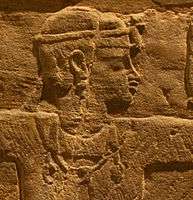
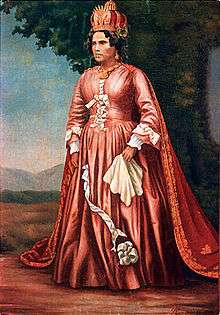
_-_Google_Cultural_Institute.jpg)





_effigy_2010_(2).jpg)


